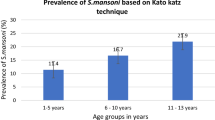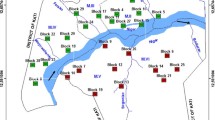Abstract
Climate is defined as the combination of climate and air elements of a given region which is usually measured for a period of decades. De-marton climate classification has been established based on many factors, including elements such as temperature and rainfall. Vesicle schistosomiasis is a parasitic disease caused by Schistosoma haematobium. This parasite lives in the blood vessels of the bladder. The parasite can cause hematuria in human and if not treated properly can lead to vesicale carcinoma. The parasite is distributed only in certain parts of the province and it is highly dispersed along the rivers of Dez, Karkheh and Karun with high emissions. In 1970, the prevalence of infection in infected foci was 23.8 %. Campaign against the parasite began in 1958 but it did not encompass all centers of infection. Preventive measures include diagnosis and treatment of patients, public health promotion, health education, drying swamps and ponds, improving the environment, cementing the irrigation canals, and the use of moluscocide eventually leads to changing the ecological and conditions of parasite and snail inhabits. Application of preventive measures resulted in the reduction of infection level to 0.7 % in 1979. By continuing struggle and intensifying preventive measures and changing ecological and climatic environment, in 2008, the examination of 3400 urine samples of students in Andimeshk district revealed no cases of the vesical schistosomiasis. It is concluded that S. haematobium and vesical schistosomiasis is eliminated from Khuzestan province southwest Iran, but the disease is still prevalent in neighboring Iran’s western border country (Iraq) and due to the special conditions of its facilities and the traffic between the two countries, it is necessary to control and eradicate the disease in Iraq by using the experiences of Iran in eliminating the disease.

Similar content being viewed by others
References
Al-Kawaz EWA (2007) Some biological and immunological aspects of Schistosoma haematobium infection. Ph.D Thesis, Baghdad University, Iraq
Alaei Taleghani M (2009) Geo-morphology of Iran. Ghoms Press, Tehran (in Persian)
Alijani B (2009) Iran climate. Payam Noor Press, Tehran (in Persian)
Arfaa F (1972) Studies on schistosomiasis in the Yemen Arab Republic. Am J Trop Med Hyg 21:421–424
Arfaa F (2009) Medical Hehminthology. Khosravi Press, Tehran (in Persian)
Arfaa F, Bijan H, Farahmandian I (1967) Present status of urinary bilharziasis in Iran. Trans R Soc Trop Med Hyg 61:358–367
Ashtari F, Sharififard H, Shabankari M,Keykavousi A, Hashemifard A, Golafshan A et al (2012) Recognition of Khuzestan. Print and Distribution Company, Tehran (in Persian)
Azar JE, Zurayf HC (1972) Present status of schistosomiasis in Lebanon. J Med 25:167–176
Baquir H (1975) Epidemiology of bilharziasis in Iraq with special reference to bilharziasis population studies. Bull Endem Dis 16:71–81
Chu KY, Massoud J, Sabbaghian H (1966) Host parasite relationship of Bulinus truncates and Schistosoma haematobium in Iran: effect of water temperature on the ability of miracidia to infect B. Snails. Bull World Health Organ 34:131–133
Chu KY, Massoud J, Arfaa F (1968) Distribution and ecology of Bulinus truncatus in Khuzestan. Iran. Bull World Health Organ 39:607–637
Daneshbod Y, Oryan A, Davarmanesh M, Shirian S et al (2011) Clinical, histopathologic, and cytologic diagnosis of mucosal leishmaniasis and literature review. Arch Pathol Lab Med 135:478–482
Gholamreza M, Jafar M, Allahbedasht M, Nikkhooy A, Mahammad KA, Rokni MB (2008) Survey of urinary schistosomiasis in Iran. Pak J Med Sci 24(6):857–860
Jafarpour A (2011) Climate of the world. Payam Noor Press, Tehran (in Persian)
Jedari Eivazi J (2010) Geo-morphology of Iran. Payam Noor Press, Tehran (in Persian)
Ketabchi AA, Moshtaghi- Kashanian GR (2012) Urinary schistosomiasis with simultaneous cell carcinoma and transitional cell carcinoma. Iran J Parasitol. 7(3):96–98
Maraghi S (2004) N Ranjbar N, Haddad, MHF. Schisto- granuloma of the fallopian tube from a low- endemic area in Iran. Acta Trop 92(1):89–90
Maraghi S, Jelowdar A, Samie M (2008) Paramedical Parasitology. Vasef Lahigi Press, Qom (in Persian)
Massoud J, Chu KY, Arfaa F (1969) Field trials of Bayluscide, sodium pentachlorophenate and copper sulphate in standing waters in Iran. Ann Trop Med Parasitol 63:189–194
Massoud J, Arfaa F, Farahmandian I, Ardalan A, Mansoorian A (1982) A progress in the schistosomiasis control program of Iran. Bull World Health Organ. 60(4):577–582
Mombeini H, Kheradmand A (2005) Schistosoma haematobium control in Khoozestan province in Iran: prosperities and failures. Med J Islam Repub Iran 19(1):19–22
Naghash AH (1980) Study the urinary schistosomiasis infection in Ajirob region in Khuzestan Province. M.Sc Thesis in Parasitology, Jundishapur University (in Persian)
Oryan A, Shirian S, Tabandeh MR, Hatam GR, Daneshbod Y (2013) Molecular, cytological, and immunocytochemical study and kDNA sequencing of laryngeal Leishmania infantum infection. Parasitol Res 112(4):1799–1804
Shirian S, Oryan A, Hatam GR, Daneshbod Y (2012) Mixed mucosal leishmaniasis infection caused by Leishmania tropica and Leishmania major and brief literature review. J Clin Microbiol 50:3805–3808
Shirian S, Oryan A, Hatam GR, Panahi S, Daneshbod Y (2014) Comparison of conventional, molecular, and immunohistochemical methods in diagnosis of typical and a typical cutaneous leishmaniasis. Arch Pathol Lab Med 138:235–240
Acknowledgments
This study is adapted from the M.Sc thesis of Mr. Dariush Hamidinia in Ahwaz Islamic Azad University. We would like to thank Farahnaz eazadpoor for his critical help in editing the manuscript. The authors express their acknowledge to Ahwaz Jundishapur University of Medical Sciences and have no conflict to declare.
Author information
Authors and Affiliations
Corresponding author
Rights and permissions
About this article
Cite this article
Hamidinia, D., Maraghi, S., Azimi, F. et al. The role of climate on prevalence or eradication of vesical schistosomiasis in Khuzestan Province of Iran. J Parasit Dis 40, 387–389 (2016). https://doi.org/10.1007/s12639-014-0515-6
Received:
Accepted:
Published:
Issue Date:
DOI: https://doi.org/10.1007/s12639-014-0515-6




